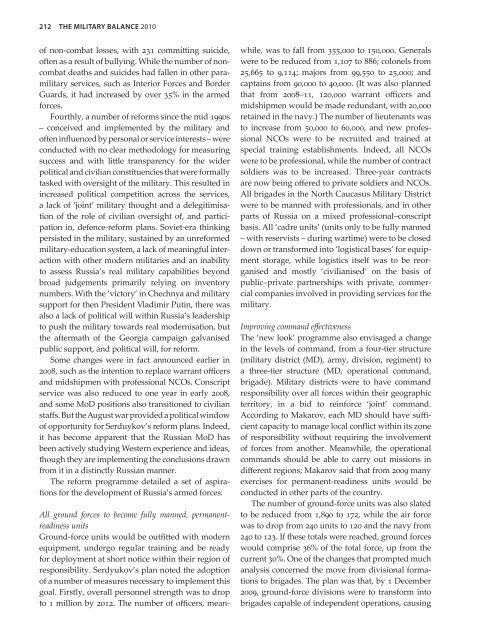Create successful ePaper yourself
Turn your PDF publications into a flip-book with our unique Google optimized e-Paper software.
212 The MiliTaRy Balance 2010<br />
of non-combat losses, with 231 committing suicide,<br />
often as a result of bullying. While the number of noncombat<br />
deaths and suicides had fallen in other paramilitary<br />
services, such as Interior Forces and Border<br />
Guards, it had increased by over 35% in the armed<br />
forces.<br />
Fourthly, a number of reforms since the mid 1990s<br />
– conceived and implemented by the military and<br />
often influenced by personal or service interests – were<br />
conducted with no clear methodology for measuring<br />
success and with little transparency for the wider<br />
political and civilian constituencies that were formally<br />
tasked with oversight of the military. This resulted in<br />
increased political competition across the services,<br />
a lack of ‘joint’ military thought and a delegitimisation<br />
of the role of civilian oversight of, and participation<br />
in, defence-reform plans. Soviet-era thinking<br />
persisted in the military, sustained by an unreformed<br />
military-education system, a lack of meaningful interaction<br />
with other modern militaries and an inability<br />
to assess Russia’s real military capabilities beyond<br />
broad judgements primarily relying on inventory<br />
numbers. With the ‘victory’ in Chechnya and military<br />
support for then President Vladimir Putin, there was<br />
also a lack of political will within Russia’s leadership<br />
to push the military towards real modernisation, but<br />
the aftermath of the Georgia campaign galvanised<br />
public support, and political will, for reform.<br />
Some changes were in fact announced earlier in<br />
2008, such as the intention to replace warrant officers<br />
and midshipmen with professional NCOs. Conscript<br />
service was also reduced to one year in early 2008,<br />
and some MoD positions also transitioned to civilian<br />
staffs. But the August war provided a political window<br />
of opportunity for Serduykov’s reform plans. Indeed,<br />
it has become apparent that the Russian MoD has<br />
been actively studying Western experience and ideas,<br />
though they are implementing the conclusions drawn<br />
from it in a distinctly Russian manner.<br />
The reform programme detailed a set of aspirations<br />
for the development of Russia’s armed forces:<br />
All ground forces to become fully manned, permanentreadiness<br />
units<br />
Ground-force units would be outfitted with modern<br />
equipment, undergo regular training and be ready<br />
for deployment at short notice within their region of<br />
responsibility. Serdyukov’s plan noted the adoption<br />
of a number of measures necessary to implement this<br />
goal. Firstly, overall personnel strength was to drop<br />
to 1 million by 2012. The number of officers, mean-<br />
while, was to fall from 355,000 to 150,000. Generals<br />
were to be reduced from 1,107 to 886; colonels from<br />
25,665 to 9,114; majors from 99,550 to 25,000; and<br />
captains from 90,000 to 40,000. (It was also planned<br />
that from 2008–11, 120,000 warrant officers and<br />
midshipmen would be made redundant, with 20,000<br />
retained in the navy.) The number of lieutenants was<br />
to increase from 50,000 to 60,000, and new professional<br />
NCOs were to be recruited and trained at<br />
special training establishments. Indeed, all NCOs<br />
were to be professional, while the number of contract<br />
soldiers was to be increased. Three-year contracts<br />
are now being offered to private soldiers and NCOs.<br />
All brigades in the North Caucasus Military District<br />
were to be manned with professionals, and in other<br />
parts of Russia on a mixed professional–conscript<br />
basis. All ‘cadre units’ (units only to be fully manned<br />
– with reservists – during wartime) were to be closed<br />
down or transformed into ‘logistical bases’ for equipment<br />
storage, while logistics itself was to be reorganised<br />
and mostly ‘civilianised’ on the basis of<br />
public–private partnerships with private, commercial<br />
companies involved in providing services for the<br />
military.<br />
Improving command effectiveness<br />
The ‘new look’ programme also envisaged a change<br />
in the levels of command, from a four-tier structure<br />
(military district (MD), army, division, regiment) to<br />
a three-tier structure (MD, operational command,<br />
brigade). Military districts were to have command<br />
responsibility over all forces within their geographic<br />
territory, in a bid to reinforce ‘joint’ command.<br />
According to Makarov, each MD should have sufficient<br />
capacity to manage local conflict within its zone<br />
of responsibility without requiring the involvement<br />
of forces from another. Meanwhile, the operational<br />
commands should be able to carry out missions in<br />
different regions; Makarov said that from 2009 many<br />
exercises for permanent-readiness units would be<br />
conducted in other parts of the country.<br />
The number of ground-force units was also slated<br />
to be reduced from 1,890 to 172, while the air force<br />
was to drop from 240 units to 120 and the navy from<br />
240 to 123. If these totals were reached, ground forces<br />
would comprise 36% of the total force, up from the<br />
current 30%. One of the changes that prompted much<br />
analysis concerned the move from divisional formations<br />
to brigades. The plan was that, by 1 December<br />
2009, ground-force divisions were to transform into<br />
brigades capable of independent operations, causing


